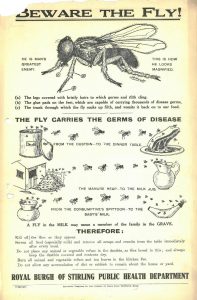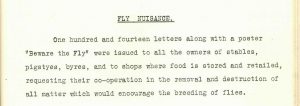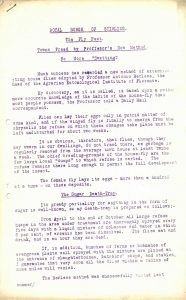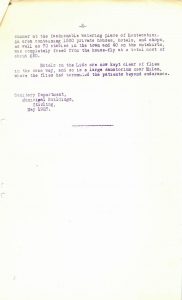Our document of the month for September is a poster found in one of the Stirling Burgh Town Clerk’s files.
This poster was issued by Stirling Burgh’s Sanitary Inspector in 1927 to shops and other businesses in the Town at that time. It gives a stern warning in colourful language of the dangers associated with house flies. At this time, before the development of antibiotics and prior to the availability of free health care for all, the infections spread by the common fly could indeed be fatal.
Sanitary Inspectors were employed in Scotland after the Public Health (Scotland) Act of 1897 and were responsible for carrying out measures for protecting public health. The Stirling Inspector’s Annual report for 1927 outlines the main responsibilities of the office including the inspection of bakeries, markets, stables, pigsties, dairies and all shops selling food. The Inspector ran laboratory tests on milk, for bacterial count and cleanliness, on other dairy products and even on whisky to ensure that it was genuine. He was also responsible for the inspection of buildings to ensure that they were fit for human habitation and were not overcrowded. Interestingly, in 1927, the Inspector reports on how many tenement buildings have been provided with sinks and toilets and how many remain without these facilities. He also reported on public conveniences, slaughterhouses, local cemeteries and investigated what are described as ‘smoke nuisances’.
A large part of the Inspector’s work related to measures designed to control infectious diseases such as Tuberculosis, measles, whooping cough and influenza. To this end there was an annual ‘Rat Week’ when local people were encouraged to deal with rodent infestations and the distribution of these posters about the house fly.
In the file with the poster there is also a report by the Inspector suggesting a fairly radical solution for the proliferation of flies in the Burgh. It is not clear from the minutes whether this was adopted, perhaps the thought of mixing molasses, water and arsenic and spraying this about the place was just a little too risky to be practical!




